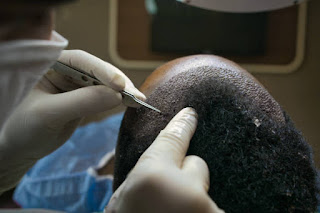HAIR GRAFT TRANSPLANT
Hair graft transplant is the procedure of
transplantation of healthy follicles from the donor area to the recipient area
of the scalp. In this beautiful world, every person wants to have a natural and
beautiful look. But unfortunately, 85 per cent of men face baldness before the
age of 50 in this beautiful world. 40 per cent of women also face baldness
before the age of 40. However, in females, the complete baldness incidence is
very low. Many factors cause baldness. This includes stress, nutrients
deficiency, side effects of chemotherapeutic drugs as in chemotherapy and some
genetic factors. The genetic factors are dominant in males. The reason for this
is that baldness is a sex-limited trait. If only one gene is present in males
then baldness is observed. In females, one gene does not cause baldness alone.
A woman would only be bald if she receives both genes from her parents. These
cases are usually not common and rare incidence has been observed. Those bald
persons who wanted to restore their natural look can avail the facility of hair
graft transplant.
There are many hair graft transplant techniques. These include Follicular
Unit Extraction (FUE), the Follicular Unit Transplant (FUT), Robotic, and
Hybrid, Laser or NEOgraft hair transplants. These techniques vary in procedure
a little bit but their main purpose is hair restoration and occasionally the
results are the same with minor differences. Before undergoing Follicular Unit
Extraction, the surgeon usually checks whether the patient is suitable for the
procedure or not. The physician usually checks whether the patient has enough
donor sites or not. In the case of men, the donor site can be either backside
of the scalp or beard or chest hair. However, in the female backside of the
scalp is only the donor site. The physician also advises avoiding the
blood-thinning drugs before a few days of surgery. He should also avoid alcohol
a week before surgery to avoid any complications during surgery. The physician may
also observe the scalp laxity. If a person has tight scalp laxity, then he is
advised to avoid the procedure. While the person with loose scalp laxity is
preferred to undergo the treatment.
While undergoing a hair
graft transplant, the patient is usually given local anaesthesia. The strip
of skin is cut and then implanted on the donor site in FUT. The incised area is
then sealed with stitches. In FUE the follicles are extracted instead of
incision and follicles are separated. With the help of a microneedle, the
recipient area is then punctured and the follicles which are separated earlier
are inserted into these follicles. There is no incision like FUT; instead,
micro holes are made which heals rapidly. In the case of a hybrid hair
transplant, the FUT and FUE are performed simultaneously. First, the strip is
cut and then follicles are separated one by one. Then by using microneedles
the micro-holes are made and then separated follicles are placed in these
holes. In a robotic hair transplant, the ARTAS robots, with the help of cameras
and software installed on it undergo the process like FUE. The algorithm system
calculates the grafts to be moved. In the NEOgraft procedure, the incisions are
made with the help of a wand that extracts the follicles using a suction
technique. In this procedure, there is the least chance of human error or scar.
This is because the suction is made by a wand and there is no incision.
After hair graft
transplant surgery, the person is advised to take care of the treated area.
He should also avoid alcohol. Smoking is not recommended to the smoker for
almost a month because it may stop the blood supply to the treated area. Direct
exposure to sunlight is not allowed immediately after the procedure. Wearing
caps and hats must not start immediately after the surgery. The transplant
procedure is performed in sessions. Some may complete in a single session while
others require multiple sessions. This also depends on the number of grafts and
the procedure which is being followed. The cost of treatment also varies from
place to place. Cost is also decided on the number of grafts or follicles to be
moved. It is also based on the number of sessions. A single session treatment
may range from $4,000 to $15,000. Multiple sessions may reach up to $50,000.
Unfortunately, insurance companies do not entertain their clients and patients
have to pay the whole amount by themselves. Our hair transplant clinic in Pakistan will provide you with a free check-up and analysis.

